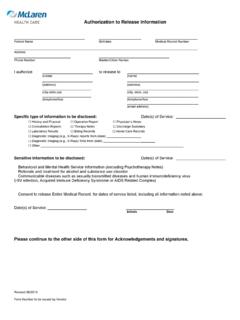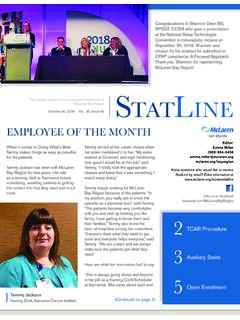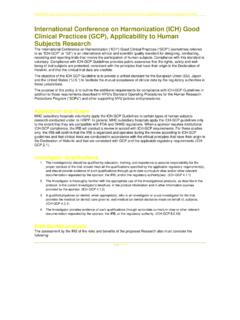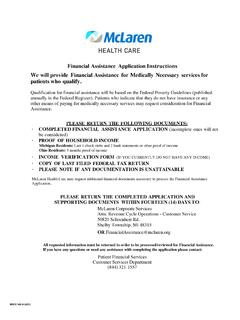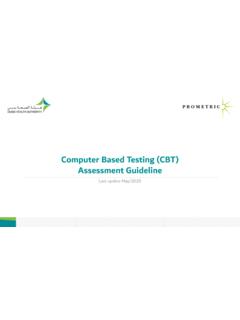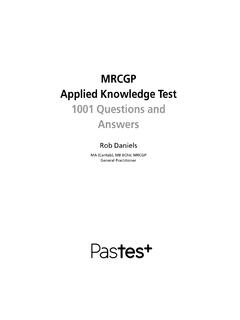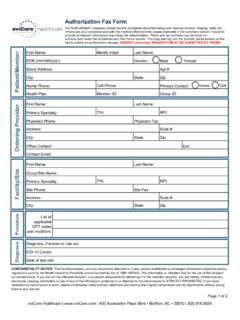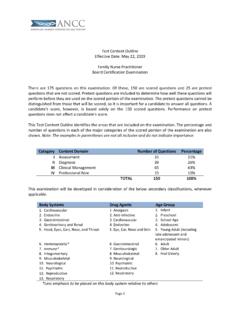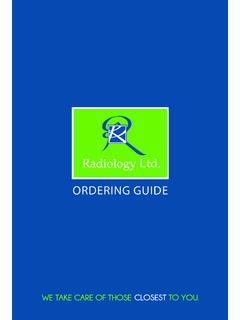Transcription of Medical Record Completion Guidelines - McLaren
1 Medical Record Completion Guidelines Medical Record Committee Approval: August 24, 2011. Staff Executive Committee Approval: September 2011. Revised: August 24, 2011. I. DEFINITIONS. A. Allied Health Professional ( Mid-Level Practitioners ) an individual, other than a licensed physician, whose patient care activities require that his authority to perform specified patient care services be processed through Medical staff channels or with involvement of Medical staff representatives. B. Attending physician primary physician providing care, or on teaching cases, the physician supervising the residents/ Medical students on the case.
2 C. Author the physician, resident or allied health professional writing or dictating a report. D. Practitioner means, unless otherwise expressly limited, any appropriately licensed physician, podiatrist, or dentist applying for, or exercising, clinical privileges in this hospital. II. REQUIREMENTS FOR Medical Record DOCUMENTATION. A. A legal, accurate Medical Record shall be maintained for every person treated as an inpatient, outpatient, or emergency patient. B. The Medical Record shall contain sufficient information to identify the patient clearly, to support the diagnosis and justify the treatment, and to document the results accurately and in a timely manner.
3 All entries shall be accurately dated and timed by the author. The Medical Record shall also contain evidence of appropriate informed consent for any procedure or treatment for which it is appropriate. 1. All caregivers providing service to the patient are authorized to document in the Medical Record on specific forms for their area or in the progress notes, including pastoral care. C. Medical Records shall be confidential, current, accurate, legible, complete and secure. D. The attending Practitioner shall be responsible for the preparation of a complete, current, accurate, pertinent, and legible permanent Medical Record for each of his patients.
4 This Medical Record shall contain: 1. Identification data;. 2. Medical history;. 3. Physical examination;. 4. Diagnostic and therapeutic orders;. 5. Evidence of appropriate informed consent;. 1. 6. Clinical observations, including results of therapy;. 7. Reports of procedures, operations, tests, and results thereof;. 8. Consultation reports when applicable;. 9. Autopsy report when appropriate;. 10. Detailed discharge instructions; and 11. A discharge summary at termination of hospitalization to include principal diagnoses, secondary diagnoses if appropriate, and prognostics. E. The hospital Medical Record shall include at least the following: 1.
5 Face Sheet Demographic information is entered at time of patient admission as follows, if available: a. Patient name, social security number, address, phone number, sex, race, age, birth b. Date, marital status, religion, church. c. Next of kin, address, phone number, relationship. d. Emergency contact, address, phone number, relationship. e. Patient employer, occupation. f. Responsible party, relationship, employer, address, phone number, social security number. g. Insurance information. 2. Coding Summary The coding summary shall include: a. All pertinent diagnoses, including complications, which can be coded using ICD-9-CM.
6 B. All operative procedures, including invasive diagnostic procedures which can be coded using ICD-9-CM and/or CPT- 4 in accordance with coding Guidelines . 3. Emergency Room Report a. All reports shall be completed within a timely manner. It is recommended the Emergency Room Report be completed immediately following the conclusion of treatment. b. Note the following when completing Emergency Room Records: i). Clinical appropriateness ii). Standard of care to support patient visit to ER. 2. History: including how, when and where an injury occurred or when symptoms first appeared. Physical Findings: including the site and approximate extent of lacerations; site, and degree and percent of body surface of burns.
7 Management: treatment given including anesthetic used, if any, and number and type of sutures, injections, shots, dressing or cast application. Diagnostic Test Ordered: include the specific diagnostic (x-ray/lab/cardio) test ordered and results. Diagnosis: including specific detailed diagnosis, state Medical condition or site, including right, left or bilateral; state type of trauma or injury, such as abrasion, contusion, concussion, lacerations, etc. c. When a patient is pronounced or DOA in the Emergency Room, the physical findings which established the diagnosis should be included in the Record .
8 4. History and Physical Examination H &P must be completed within 24 hours after admission either in written or dictated form. A History and Physical Examination Report must be completed prior to the initiation of any surgical or other invasive procedure. No patient shall be taken to the operating or procedure room unless a History and Physical (appropriate for the procedure being performed) and a preoperative diagnosis have been written or dictated and are available on the Medical Record at the onset of the procedure. All H&P's require Completion of the Osteopathic musculoskeletal Examination.
9 If the H&P is dictated, the physician completing the H&P must complete the Osteopathic musculoskeletal Examination paper form and place in the patient's Medical Record . The required History and Physical may be completed up to 30 days prior to an admission and/or procedure, but an updated examination is required within 24. hours of admission or registration, but prior to surgery or a procedure requiring anesthesia service. A History and Physical Examination performed up to 30. days prior to the admission will be accepted if the following are included in an addendum on the H&P or in the progress notes: -pertinent additions to the history.
10 -subsequent changes to the physical findings;. -statement the History and Physical form was reviewed, signed and dated. Failure to complete the History and Physical may result in cancellation of the procedure unless the physician states in writing that such a delay would be detrimental to the patient. If such is stated, the History and Physical is to be 3. completed within 24 hours of the emergency procedure as documented by the physician. (These provisions may be waived in extreme emergency, but a preoperative diagnosis shall be recorded in the Medical Record and the History and Physical completed within 24 hours post-procedure.)
